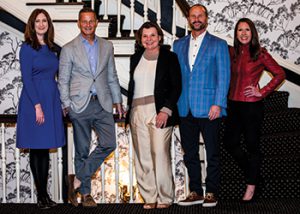TECHNOLOGY BUILT FOR CHANGE
M3 and Holmes Murphy partner with others to form BrokerTech Ventures
By Dennis H. Pillsbury

As technology has become more and more empowering for agencies, the industry has experienced a broad range of impediments to successful integration of tech-based solutions, given each agency’s way of doing business. Perhaps among the biggest impediments has been determining which of the plethora of solutions offers the greatest opportunity for success.
There was a need for someone—or some organization—to evaluate technologies with a view toward determining how they can help independent agencies and their clients find the best ways to determine risk, mitigate or eliminate that risk and lower the overall cost of risk. Out of that need, 2019 saw the birth of BrokerTech Ventures—the brainchild of Mike Victorson, CEO of M3 Insurance, Madison, Wisconsin, and Dan Keough, chairman and CEO of Holmes Murphy, Waukee, Iowa. With Dan and Mike serving as co-CEOs of the new entity, BrokerTech Ventures has attracted 15 super-regional agencies and 14 insurance companies to provide their time and resources to, as Dan puts it, “find a better way to utilize technology for the benefit of all.”
This collaboration of competitors is something I have observed over my 50 years of writing about the insurance industry, and it is especially prevalent in the independent agency ranks, where there is a great willingness to share ideas and help other agencies succeed. As Dan notes, “We have friends in the industry. We have always been willing to share new ideas with them and to collaborate to enhance the value chain for our industry overall.
“At Holmes Murphy, we are entering our 90th year of operation and are proud to be private and independent and successful, thanks in part to friends in the industry with whom we’ve collaborated,” Dan continues.
“We’re always looking for new ideas that we can implement,” he adds. “That’s one of the reasons that we’ve grown to reach $275 million in revenue with roughly 1,000 employees and a marketing territory that encompasses most of the Midwest, that ranges from Minnesota to Texas and Arizona to Illinois, and that includes an operation in the Cayman Islands.”
“M3 Insurance is now in its 55th year, “Mike notes, “with $110 million in revenue and 400 employees. Dan and I are long-time friends and, even when we compete, we’ve found that sharing ideas still makes sense. We’ve both benefited and have noticed that in recent years many of those ideas involve ways to better use technology to create a better buying experience for our clients.”

“We have friends in the industry. We have always been willing to share new ideas with them and to collaborate to enhance the value chain for our industry overall.”
—Dan Keough
Chairman and CEOHolmes Murphy
He says the approach helps his firm, “drive down costs and provide better risk management solutions. It was because of these successes that we felt a company dedicated to finding the best broker-centric technologies and supporting those technologies would be beneficial to us, certainly, but to the industry overall.”
“The future of the independent agency system hinges on its ability to stay in the game, with joint leverage of relationships and enhanced support by technology and innovation,” Dan adds. “Today’s economy is no longer based on winners and losers but on playing the infinite game where you constantly get better and strive to keep playing.”

From a less-than-stellar start
Technology has an interesting history in the independent agency ranks, starting off as what many considered to be a giant headache, where company proprietary systems required agents to have a multitude of dumb terminals so they could communicate with each carrier they wanted to represent. I still remember one visit to a Texas agency where I asked the owner how many companies he represented and he responded by bringing me to a long room lined with terminals and quipped, with tongue firmly in cheek: “Count the terminals.”
With that as background, it is hardly any surprise that agents were not thrilled about embracing technology that at the time seemed built only to make it easier for insurance companies to conduct business. It was seen as yet another way to try and get independent agents to be less independent by offering proprietary systems with a few bells and whistles that might help agents grow their business with that company.
Some four decades later, some of the problems that have since disappeared seem almost laughable. The fright over the Millennium Bug, which proved to be less than catastrophic, strikes many of us as especially silly today, since it emerged due to the need to save space on our mainframes. Those in charge of programming those behemoths only used the last two digits for the year. Considering that right now we carry around a computer, euphemistically called a phone (only old f**ts like me use it for that purpose), which has greater capacity than computer rooms loaded with mainframes, it seems almost insane that such a measure made sense.
Tech becomes friendly
Today, independent agents no long-er eschew technology but see it as a partner that frees them up to do what they do best—provide advice to clients; the technology handles areas for which it is uniquely adapted. Nearly every month, when I interview agencies about their successes, they talk about their relationship with technology and how it has helped them succeed. But they also almost always mention how they have had to cobble together technology, normally adding software solutions to their management systems.

The results have been astounding. Independent agencies are defying prognostications that the internet would make them obsolete. Instead, the technological revolution that has started within the independent agency ranks has allowed them not just to level the playing field with online competitors, but to provide the value-added services that insurance buyers need in addition to an online presence.
What has been missing, however, is a voice within the technological universe that looks at and evaluates the multifarious “solutions” offered by technology developers to see if they make sense for agents and their clients.
At least that was missing until BrokerTech Ventures entered the scene.
The five towers
In its first three years, BrokerTech Ventures (BTV) has seen 48 startups in the insurtech landscape join its accelerator program in the United States, Israel and Latin America. The accelerator program is one of five towers designed to support, test and communicate innovative tech solutions for the insurance industry.
“As we look at launching our fourth year in the accelerator space,” Dan says, “I continue to be amazed with the depth and level of expertise, products and solutions being brought forward by startups for the betterment of the insurance landscape and our clients. In 2023, I believe we can expect new insurtech solutions with greater influence and even more diversity of thought for the industry.”
The BTV Accelerator is an “innovation hub” that provides a proof-of-concept environment for broker-centric products and technology solutions, ultimately bringing validated solutions to the industry. The broker and company partners provide the startups with a wide distribution network, while they in turn have the opportunity to use the latest technologies and products to help them identify risks sooner. This lets agents and brokers provide even better service to customers and ultimately drive down costs for all participants in the risk management environment, creating a classic win-win-win situation, where startups get the acceleration they need to grow and thrive, and brokers, agents, insurance companies, wholesalers, and consumers all enjoy a reduction in the overall cost of risk.

An initial review of new submissions to the BTV Accelerator began in late 2022, whittling down the field to the top 20 startups. In March, BTV partners will dig deeper into the products, companies and teams. A five-week accelerator program will begin in April, with more than $500,000 in funding at stake for the selected broker-centric startups ,with each of 10 selected startups receiving up to $50,000.
The second tower is an early-stage investments program through BTV’s owner, partner and sponsor channels. The investments allow the opportunity to scale insurtech innovation further ans faster through the vast broker and insurance company distribution channel created by BTV. It should be pointed out that the broker members of BTV represent more than $2 billion in revenue.
The third tower involves bending the innovative curve through strategic partnerships with some of the greatest insurtech forces in the industry. Through engagement in the BTV Carrier Innovation Summit Series, conferences, innovation platforms, and college and university channels, BTV brings innovation quickly to the surface for its stakeholders and the industry overall.
The fourth tower involves access to capital through BTV’s alignment with strategic capital partners who share in a parallel vision in BTV’s intentions to embrace and scale insurtech solutions. This capital tower will be deployed either in conjunction with the early-stage investment tower or as an individual source of investment for insurtech startups convened through BTV.
The final tower is media and communication, with BTV serving as the voice of the broker/insurtech ecosystem. BTV has created strategic partnerships with some of the greatest media channels in the industry. Through this tower, what BTV learns from its accelerator, early-stage investment, innovation, and capital towers will be widely disseminated to the broker insurance audience through traditional media outlets, as well as social and strategic event engagements.

“Enthusiasm for what tech offers has replaced the fear. We are literally learning how to adopttechnologies to be better partners with
our customers and our companies.”
—Mike Victorson
CEO M3 Insurance
Enthusiasm replaces fear
“Enthusiasm for what tech offers has replaced the fear,” Mike concludes. “We are literally learning how to adopt technologies to be better partners with our customers and our companies.”
Dan adds that the people working at their desks at Holmes Murphy enjoy being challenged and no longer fear the encroachment of technology into their jobs. “Rather, they are seeing technology free them up to focus on customer-centric activities that help to drive down costs. We’ve already taken care of the easy ways to use technology where about 20% of staff time now has been replaced or will be replaced by technology.
“BTV’s efforts will certainly help us find new and innovative ways to use technology to better serve our clients and will help our people be more productive and fulfilled,” he concludes.
Rough Notes is proud to be part of this effort as a media partner. We are excited to be part of the technological revolution that is coming quickly, where we are convinced that independent agents will continue to be the leading marketing system in the industry as it makes even better use of technology to effectively serve clients and develop unique ways to help them reduce their overall cost of risk.
The author
Dennis Pillsbury is a Virginia-based freelance insurance writer.





